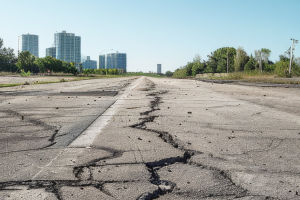
Hey Lykkers! Earthquakes are among the most powerful and terrifying natural disasters we can experience. They can completely destroy cities, cause widespread devastation, and leave lasting psychological scars.
But here's the thing: what we see on the surface is just a small part of the story. There’s a hidden world beneath our feet that plays a massive role in shaping the intensity of these events.
Today, we're diving into some new, exciting research that reveals how earthquakes are much more complex than we once thought. It turns out that there are "invisible deformations" happening far from the main fault lines—and these deformations could have a huge impact on the damage an earthquake causes. Let’s explore this together!
The Basics of an Earthquake: What Really Happens?
When two tectonic plates slide past each other, earthquakes occur. But the real disaster doesn't happen gradually. Instead, these plates suddenly slip, creating massive shifts that cause destruction in a split second. Usually, the worst damage is seen along the fault line, where the earthquake originates.
However, the recent earthquake that struck Turkey and Syria on February 6, 2023, showed us that earthquakes are more unpredictable than we thought. The earthquake, measuring 7.8 and 7.6 magnitudes, caused widespread damage far away from the fault line itself.
What’s Happening Beyond the Fault?
Here’s where it gets interesting: Imagine you’re pulling on a long, thin piece of fabric in opposite directions. Most of the damage happens along the main tear (the fault), but if you pull hard enough, small tears can appear in other places, even far from the original tear. That’s exactly what happened in the Turkey-Syria earthquake—the rupture started at the fault line, but the stress and energy spread much farther, causing significant damage in areas far away from the epicenter.
This phenomenon—called "off-fault damage"—is a game-changer in how we understand earthquakes. The research team from King Abdullah University of Science and Technology (KAUST) studied this and found that damage could extend up to 5 kilometers away from the fault, far beyond previous estimates.
Using Technology to Uncover Hidden Damage
Thanks to cutting-edge technology, the researchers were able to uncover these hidden deformations. They used Synthetic Aperture Radar (SAR) from satellites, which allowed them to measure tiny movements in the Earth’s surface. By comparing before-and-after images, they mapped the damage even in remote areas that were hard to reach.
Dr. Jihong Liu, the lead researcher, said, "Radar satellites have revolutionized our study of earthquakes. They allow us to analyze wide areas with incredible detail, without having to rely on field observations."
Why Does This Matter?
Here’s why this discovery is so important: when scientists calculate earthquake risks, they usually focus on slip rates along the fault line—basically, how much the Earth’s crust shifts. But if they ignore the off-fault damage, they could be underestimating the potential size and frequency of future earthquakes.
Dr. Liu explains that including off-fault damage in calculations could help scientists better predict future earthquakes, which could ultimately save lives and reduce destruction. He suggests that to get a clearer picture of earthquake behavior, we need to measure slip rates up to 5 kilometers away from the fault.
What Can We Do With This Information?
1. Improve Earthquake Models: Including off-fault damage means scientists can get a more accurate sense of how big and how often earthquakes might occur.
2. Better Infrastructure Design: Engineers can design more earthquake-resistant buildings that can withstand not only fault ruptures but also the spreading ground deformation.
3. More Accurate Risk Assessments: Governments can update hazard maps to consider these newly discovered zones of damage, helping cities and communities prepare better.
The Big Picture
While earthquakes will always be a force of nature, these new findings are paving the way for safer, more resilient communities. Understanding the full extent of earthquake damage—beyond the fault lines—gives us the tools to plan smarter, predict better, and build safer. Isn’t that exciting?
So what do you think, Lykkers? Are you ready for a world where we can predict earthquakes more accurately and save lives? Let us know your thoughts!
The New Earthquake Mystery is Not Making The Big Picture Any Simpler
Video By "Just Icelandic"


